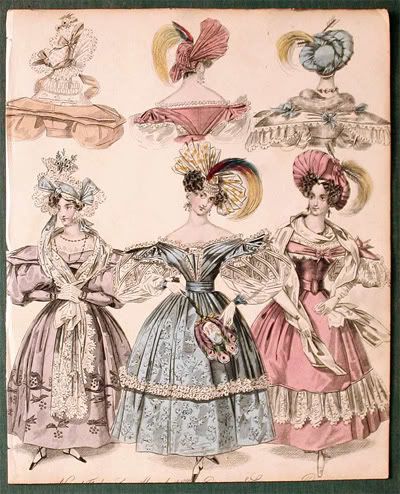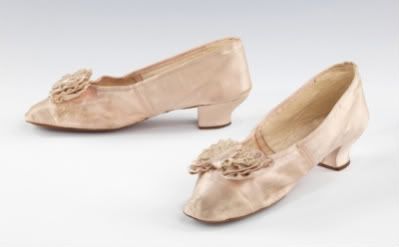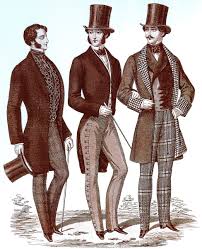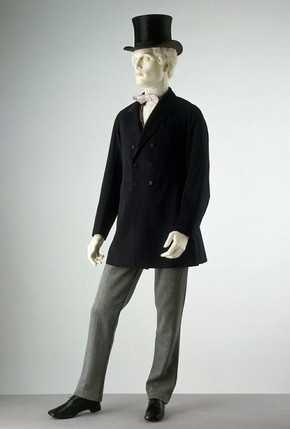Things are starting to LOOK a little bit more "normal" in the 19th century. We started with the Victorian period.
Victorian fashion is fun, beautiful, and great for women because we can wee the actual form of the body!
 |
| Leftover empire-waisted dresses from the earlier century |
 |
| Examples of the gigot sleeve. |
Women's fashion in the early 19th century offered lots of options and different silhouettes. The waistline of dresses lowered once again and this meant TIGHTER FITS so, corsets. Corsets were "lightly" boned and featured a deep busk. Sleeves of dresses were either short and puffy for nighttime and long sleeves for the daytime. When full skirts were worn, so were several petticoats or the later crinolines and hoops.

Necklines usually were high and were finished with a SMALL collar. The neckline could also be v-shaped, or draped with crossing folds. If the neckline was very low, it was filled in with a
chemisette.
The
gigot sleeve was full at the shoulder and decreased in size until it ended in a fitted cuff on the wrist.
 |
| Why, yes, I am in pain. What else is new? |
The
Marie sleeve was full but tied at intervals with bands or ribbon. Women wore
shawls in place of capes and coats.
 |
| Bustles galore!!! |
Skirts were long until they shortened to ankle-length and higher in the the early '30s, but then went right back down again! In the '20s skirts were fitted through the hips and then became fuller with pleats and gathers. Later in the '60s,
crinolines were employed to support the very full skirts. A crinoline is a petticoat supported by a frame of STEEL hoops. The
bustle, a structure worn under the skirt at the back, came into fashion in the 1880s but was short lived. The bustle helped create the highly idealized image of the female form, along with the tight corsets. Bustle gowns featured lots of gathering around the bustle area and puffed trains.
 |
| Dresses worn with crinolines. Yikes! |
 |
| 19th century dress with collared neckline |
Fabrics in fashion were
muslin,
cotton,
challis,
merino, and
batiste.
 |
| Early corsets |
 |
| Weren't they lucky? |
Ladies generally parted their hair in the middle and wore tight curls around the face with a bun. Later, false hair was used for curls. The
Chinoise style was created by pull the hair into a knot at the top of the head while the hair in front was done in curls. Women also wore
bonnets, day caps, and large-brimmed
hats with lace and feathers. Among other accessories for women were gloves,
parasols, and stockings. Slipper-like shoes were worn, as well as small heels and evening boots.
 |
| I think I could swing these! |
By the 1880s there was a group of elitist women that started to wear simpler styles that required less corsetry and understructures. These women were wearing a style called "artistic" dress. Ain't nobody got time for crinolines!
 |
| Ah, the symbolism of the crinoline... |
At the end of the century, skirts once again reached the floor, corsets were tight, and skirts were padded slightly. Tops of sleeve grew larger and collars were high and stood up.
Watch out, here come paper patterns and catalogs!
 |
Hats, trousers, and moustaches
made our men sexy. |

Men's fashion in the 19th century underwent great change. Coattails were long but the garment was cut much
shorter in the front. HELLO PANTS! Men's breeches lengthened to
trousers in the evenings. What's that you say? You want
tall hats back? You got 'em! Later in the century, men began wearing trousers in the evenings and the daytime, with a
short waistcoat and a double-breasted
frock coat. This century also welcomed
beards and
moustaches, my favorite!
 |
| Dapper gents and striking ladies |














No comments:
Post a Comment